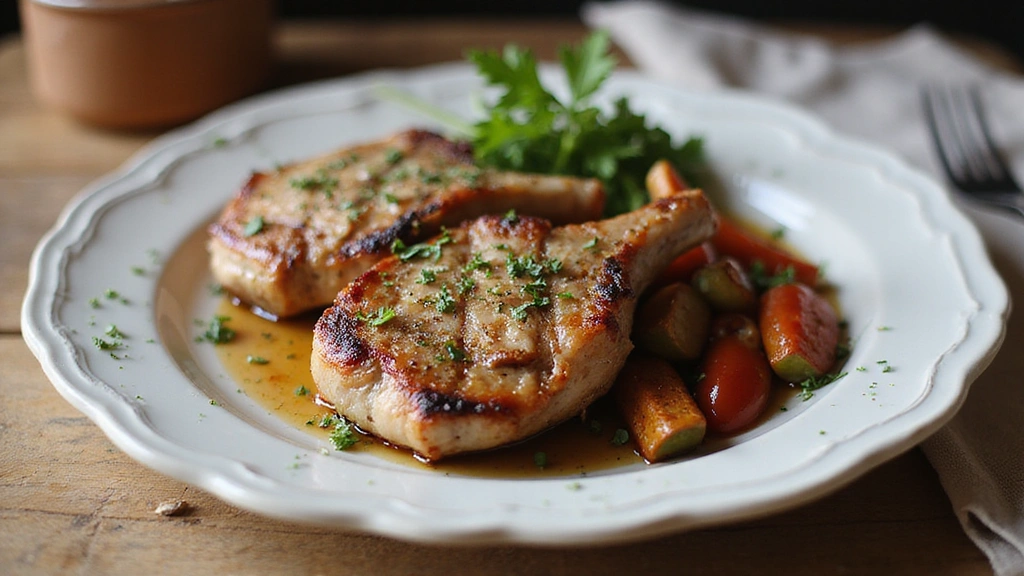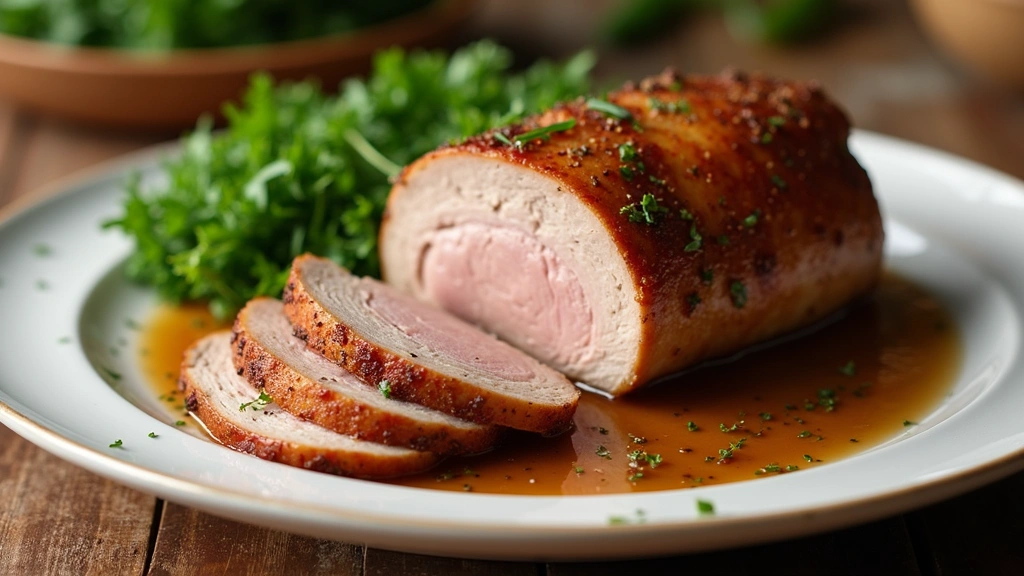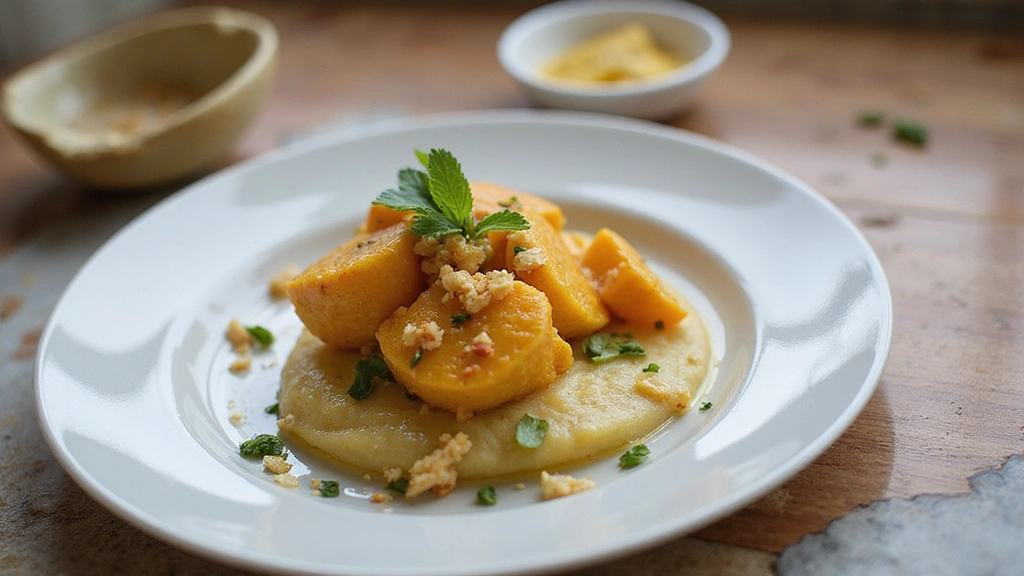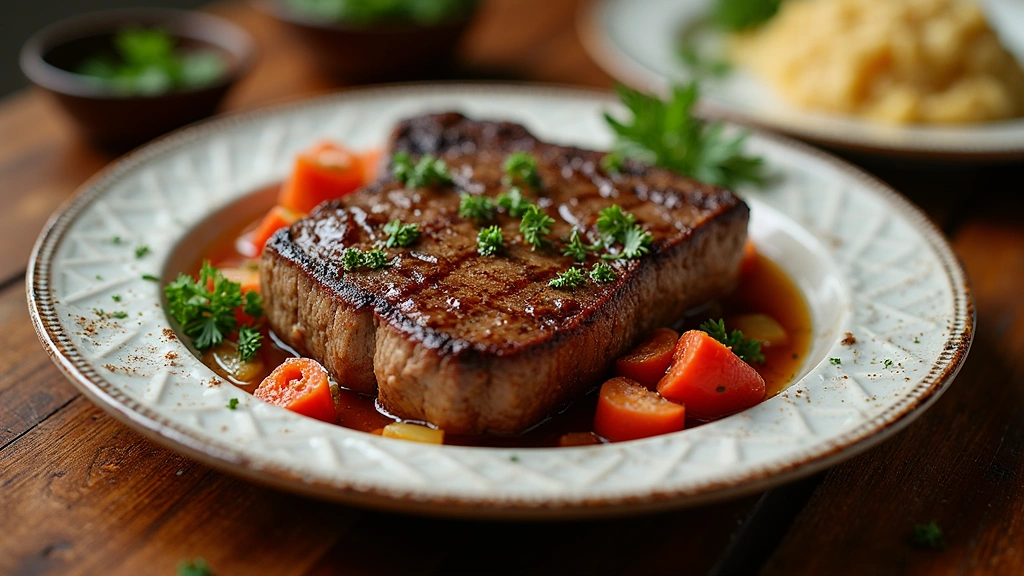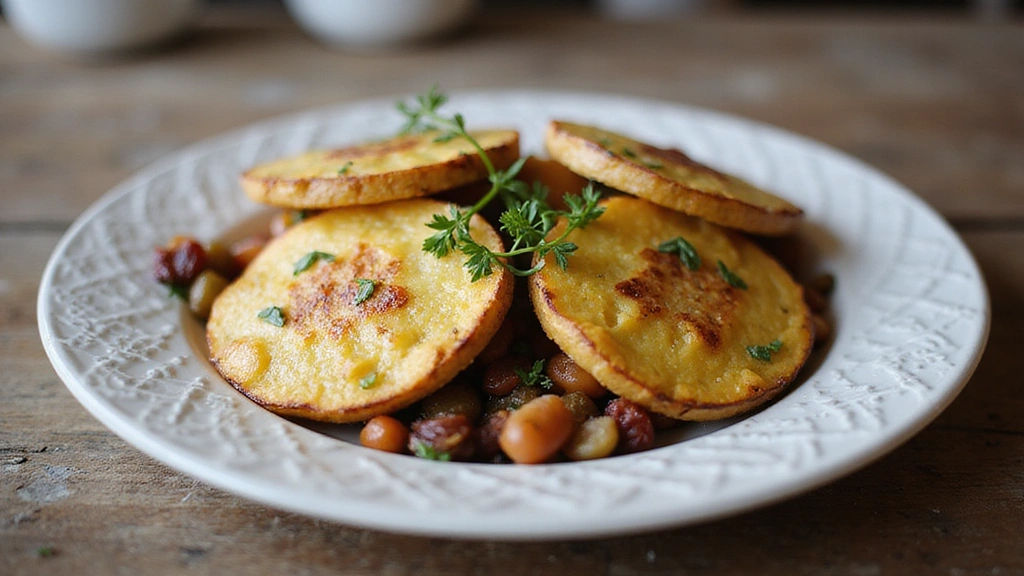Pan-seared pork chops are a delightful centerpiece for any meal, combining savory flavors with a satisfying texture.
The rich, juicy meat paired with a golden, crispy crust makes for a dish that’s both comforting and indulgent.
I first fell in love with this recipe during a family gathering, where the aroma of perfectly cooked pork chops filled the kitchen, creating a warm and inviting atmosphere.
Whether you’re cooking for a weeknight dinner or a special occasion, these bone-in pork chops will impress everyone at the table.
The History and Cultural Significance
• Pan-seared Pork Chop Recipes trace their origins to ancient Europe, where pork was a staple protein in many households.
• The dish evolved over decades as cooking techniques became more refined, leading to the popular searing method that locks in flavor and moisture.
• In American culture, this dish traditionally appears at family gatherings and holiday celebrations, symbolizing togetherness and comfort.
• While many variations exist across different regions, the authentic version maintains its focus on high-quality meat and simple seasoning that highlights its natural flavors.
Recipe Overview
Nutritional Information (per serving)
Ingredients
Essential Equipment Guide
Cast Iron Skillet: This heavy-duty skillet is essential for achieving a perfect sear on the pork chops. The even heat distribution helps create a crispy crust while keeping the meat juicy. Look for one that retains heat well and has a smooth cooking surface for best results.
Meat Thermometer: A reliable meat thermometer ensures that your pork chops are cooked to the perfect internal temperature, preventing overcooking. Choose one that provides quick readings and has a probe long enough to reach the center of thick cuts.
Sharp Knife: A sharp knife is crucial for slicing the pork chops against the grain for tender bites. Opt for a chef’s knife or a carving knife that feels comfortable in your hand to make precision cuts effortlessly.
Preparation Methods
Searing: Searing is the technique of cooking the surface of the meat at high heat to create a flavorful crust. It’s crucial for the flavor development of the pork chops. Ensure your skillet is hot enough before adding the meat to achieve the perfect sear, and don’t overcrowd the pan.
Resting: Allowing the pork chops to rest after cooking helps redistribute the juices throughout the meat, resulting in a more tender bite. Rest the chops for at least 5 minutes on a cutting board, loosely covered with foil, to keep them warm while they finish cooking.
Making Herb Butter: Combining softened butter with herbs and garlic creates a delicious finishing touch for the pork chops. Use room temperature butter to ensure it mixes easily, and feel free to experiment with other herbs based on your taste preferences.
Step 1: Prepare Ingredients
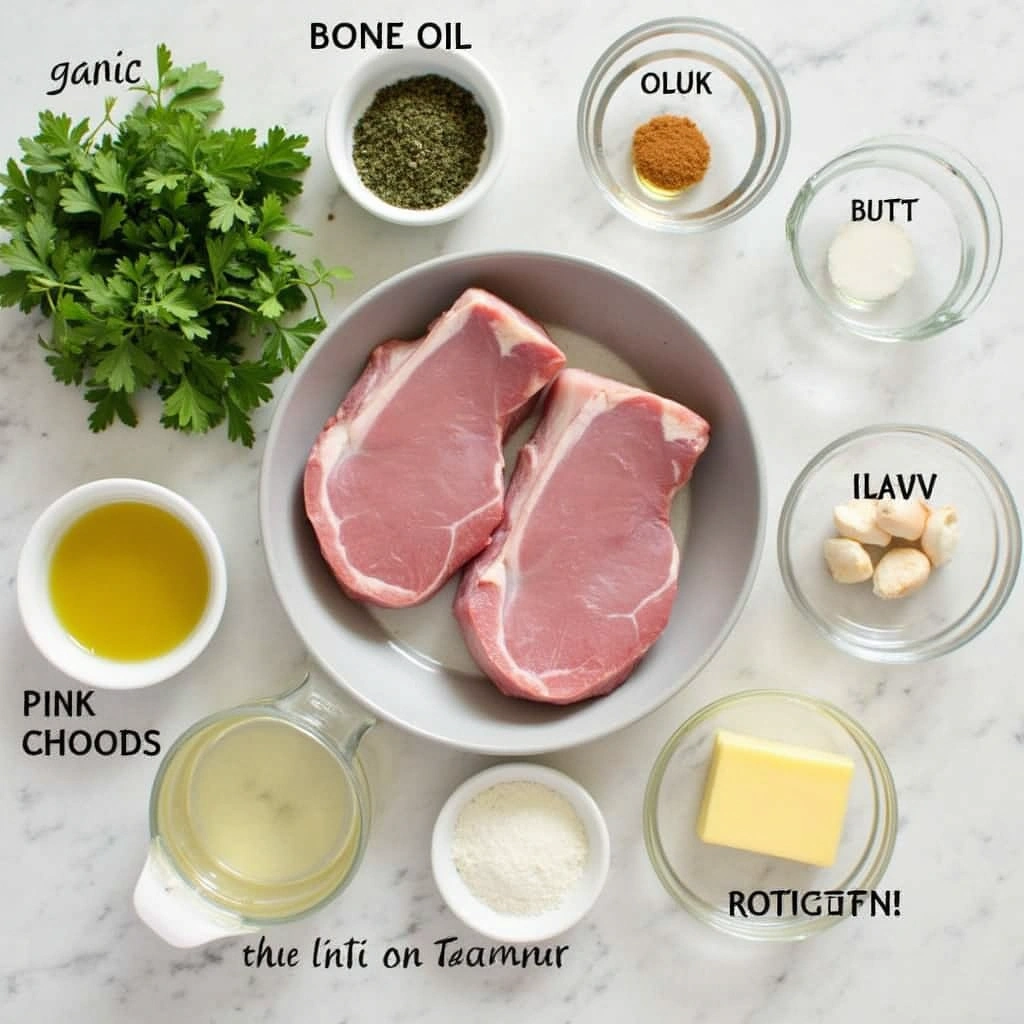
Gather all the ingredients needed for the recipe.
Ensure the pork chops are at room temperature for even cooking.
Prepare the herb butter by mixing softened butter with minced garlic and chopped herbs in a bowl.
Set aside to allow the flavors to meld while you cook the pork chops.
Step 2: Season the Pork Chops
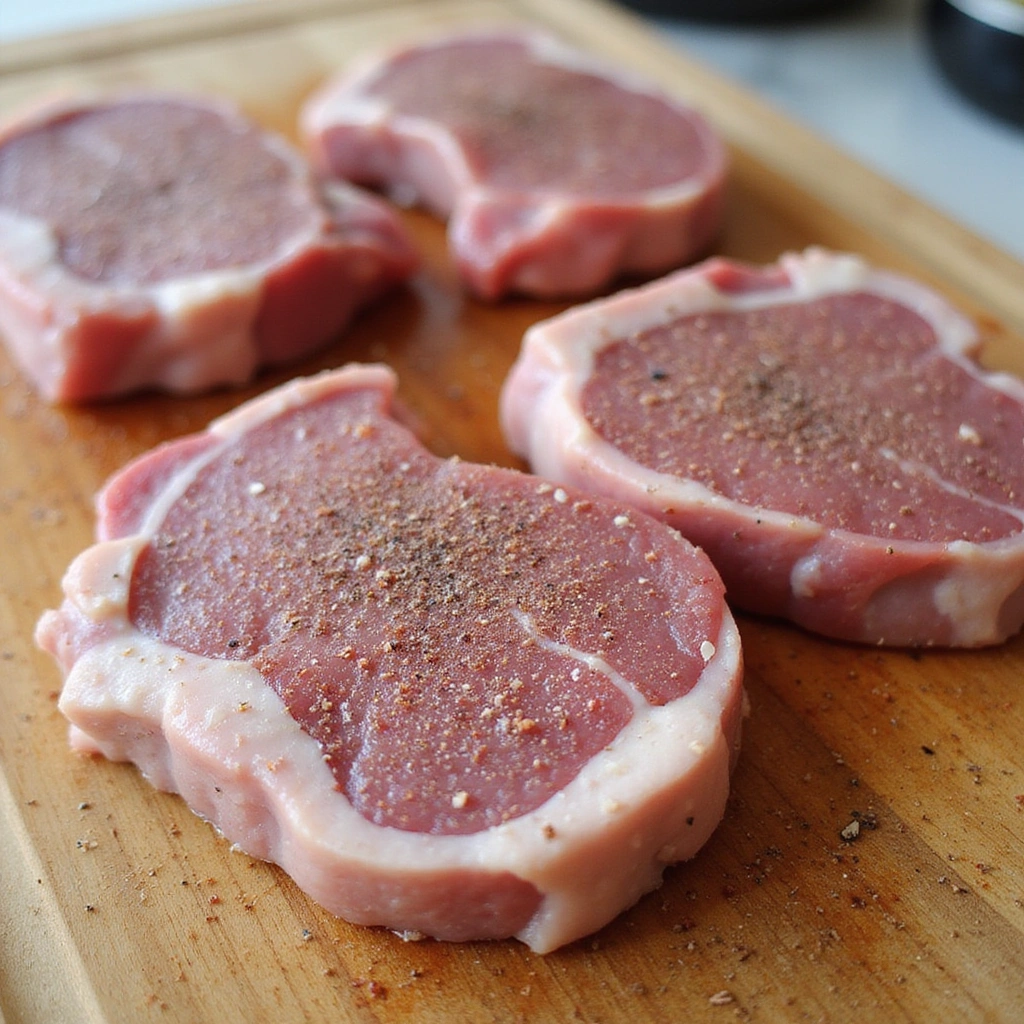
Generously season both sides of the pork chops with salt and black pepper.
Make sure to rub the seasoning into the meat for maximum flavor.
This step is crucial as it enhances the natural flavors of the pork.
Set the seasoned chops aside for about 10 minutes to allow the salt to penetrate.
Step 3: Heat the Skillet
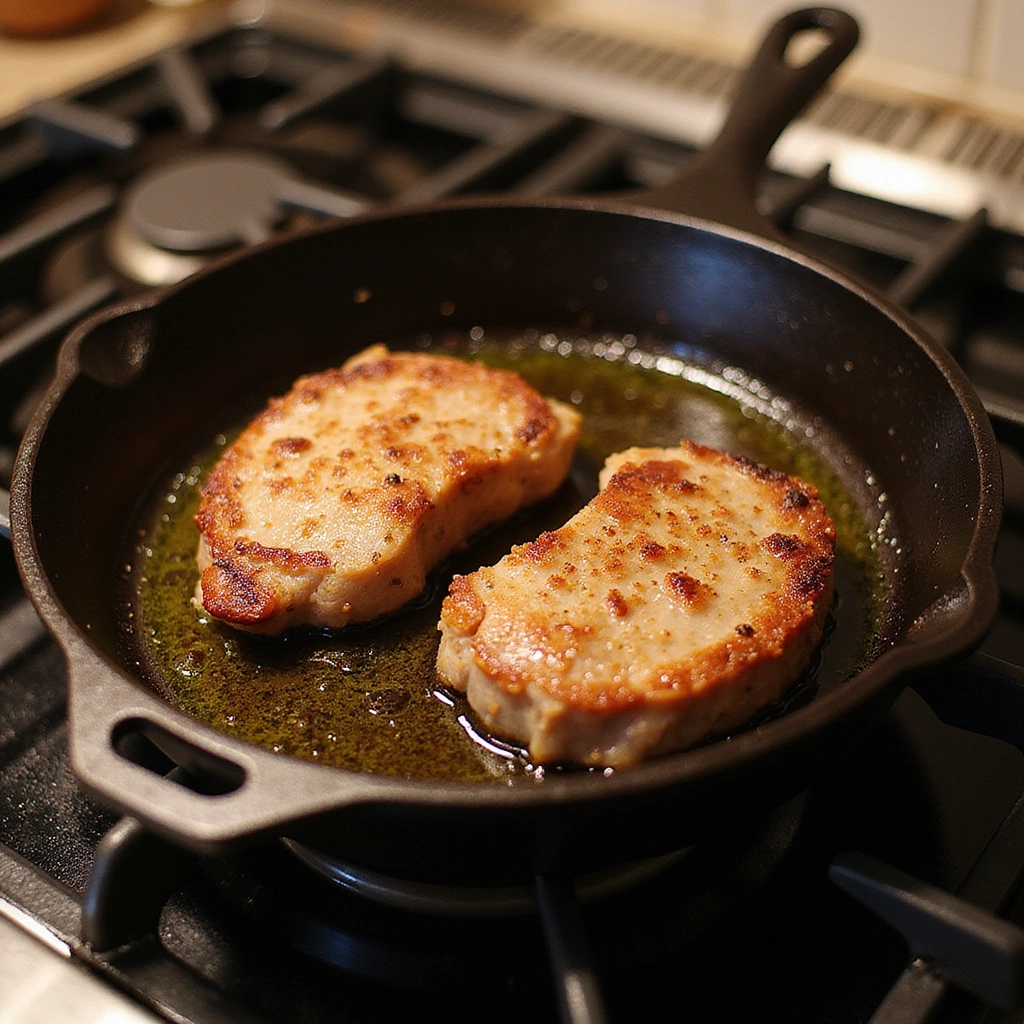
Place a cast iron skillet over medium-high heat and add olive oil.
Allow the oil to heat until it shimmers, indicating it’s hot enough for searing.
This step is vital for achieving a beautiful crust on the pork chops.
If the oil starts to smoke, reduce the heat slightly to avoid burning.
Step 4: Sear the Pork Chops
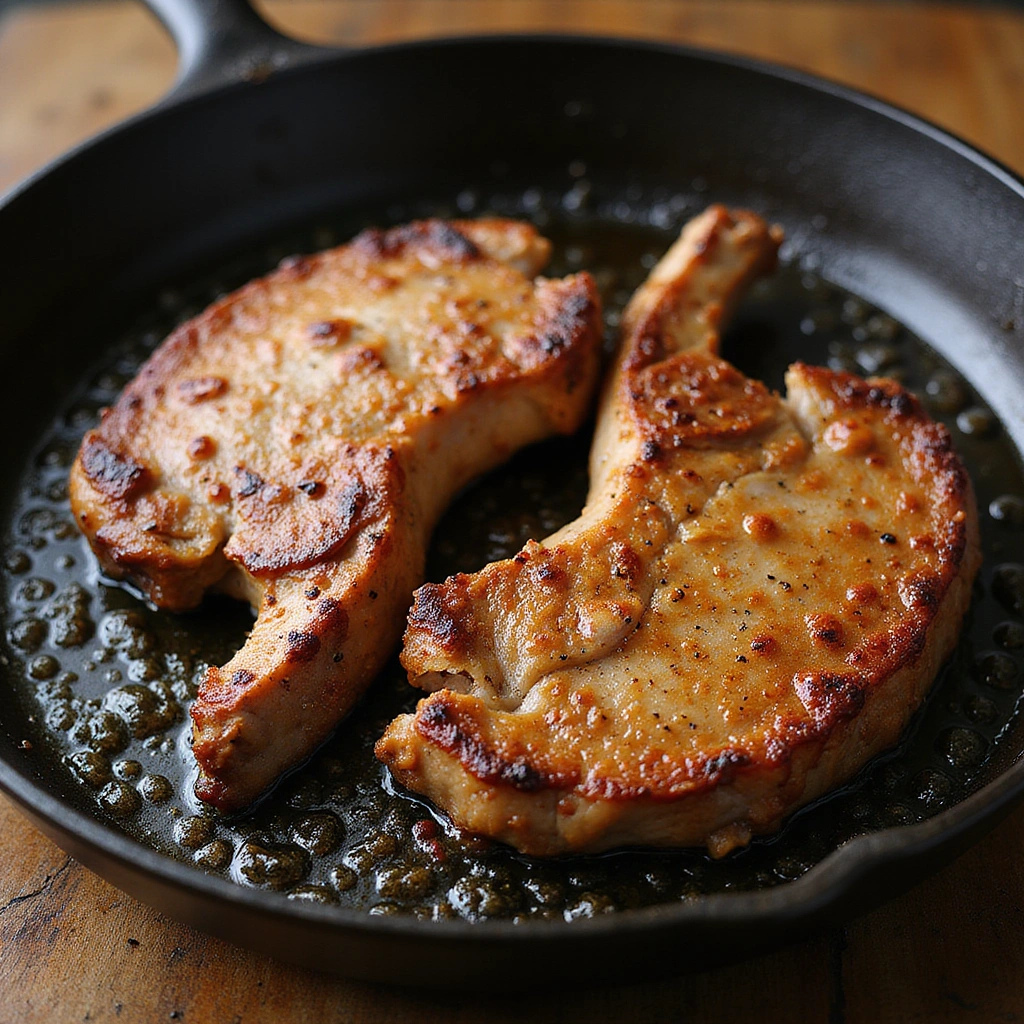
Carefully place the seasoned pork chops into the hot skillet, laying them away from you to avoid splatter.
Cook the chops for about 4-5 minutes without moving them to develop a nice crust.
After the first side is golden brown, flip the chops using tongs.
Cook for another 4-5 minutes on the other side until they reach an internal temperature of 145°F.
Step 5: Add Herb Butter
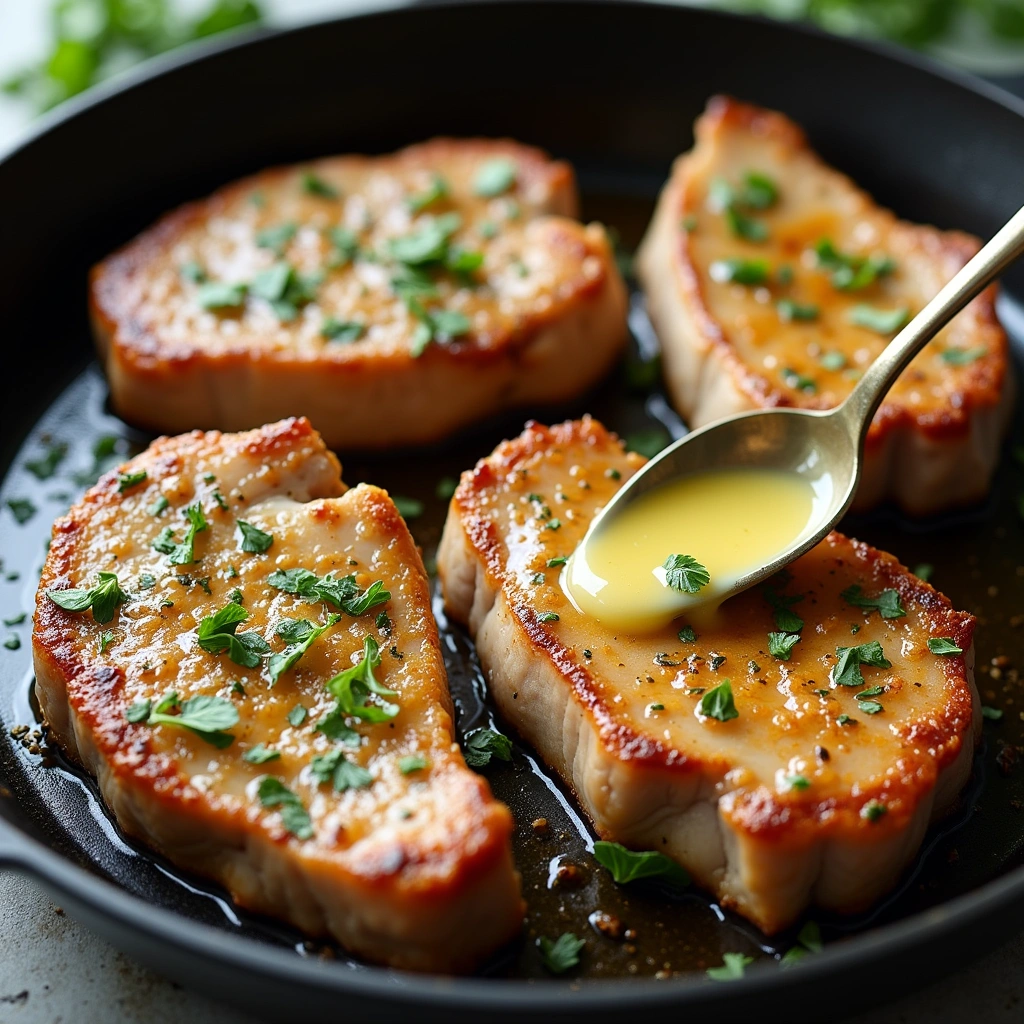
Once flipped, add the herb butter to the skillet around the pork chops.
Baste the chops with the melted butter using a spoon for added flavor.
This step enriches the dish and enhances its aroma.
Continue cooking for another minute while basting until fully cooked.
Step 6: Check Doneness

Use a meat thermometer to check the internal temperature of the pork chops.
They should read 145°F for perfect doneness.
If necessary, cook for an additional minute and check again.
This ensures the pork is safe to eat while remaining juicy.
Step 7: Rest the Pork Chops
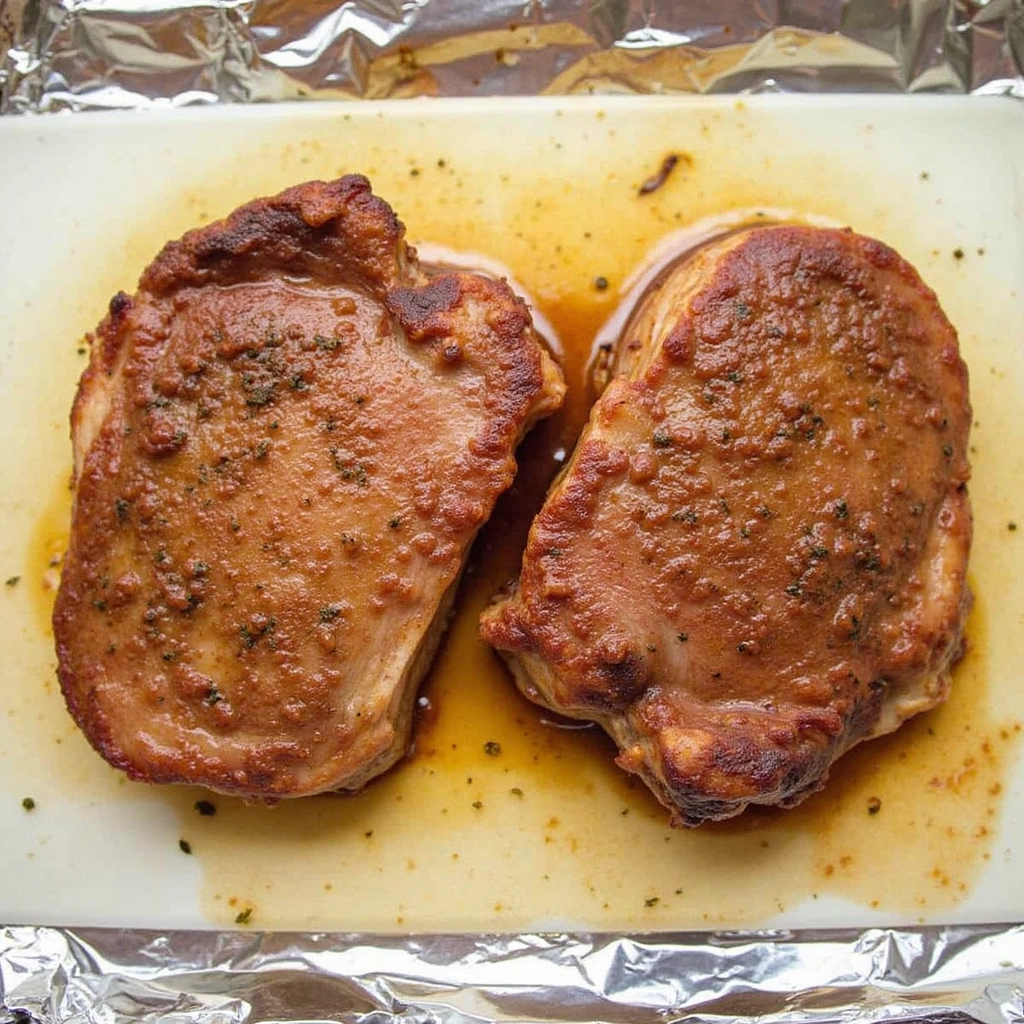
Once cooked, transfer the pork chops to a cutting board and loosely cover them with foil.
Let them rest for at least 5 minutes to allow juices to redistribute.
This step is essential for ensuring tender and juicy meat.
Avoid cutting into them right away to keep the juices intact.
Step 8: Serve and Enjoy
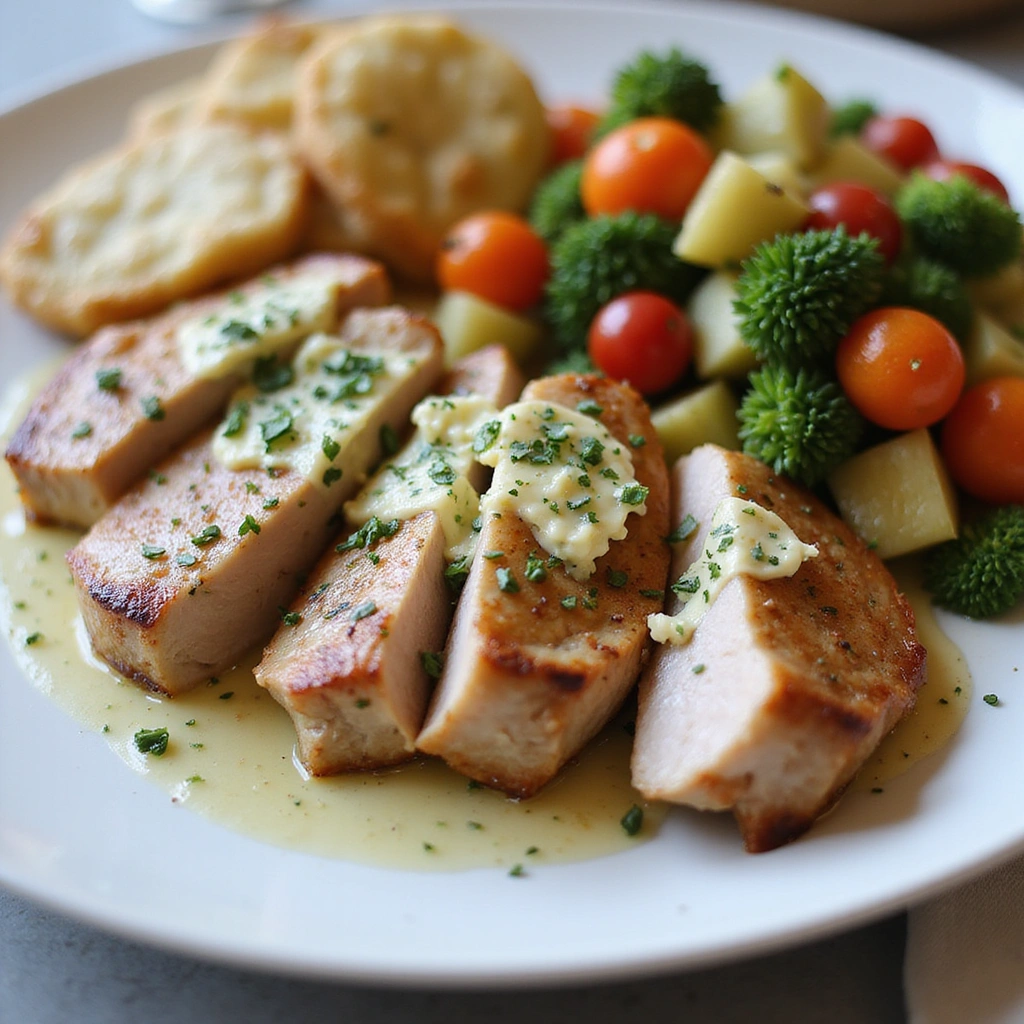
Slice the pork chops against the grain for optimal tenderness.
Plate them and drizzle any remaining herb butter from the skillet over the top.
This adds a beautiful gloss and extra flavor to the dish.
Serve with your favorite sides for a complete meal.
Critical Timing and Temperature Guide
Searing Time: Sear each side for 4-5 minutes until a golden-brown crust forms. Look for a deep color and slightly crispy texture. Avoid moving the chops during this time to achieve the best sear.
Resting Time: Allow the pork to rest for at least 5 minutes after cooking to ensure juices redistribute. This is key to preventing dry meat. Cover loosely with foil to retain warmth during resting.
Internal Temperature: Ensure the internal temperature reaches 145°F for safe consumption and optimal juiciness. Use a meat thermometer to check the thickest part of the chop without touching the bone.
Pro Tips for Pan-seared Pork Chop Recipes
• Ingredient Selection: Choose high-quality, bone-in pork chops for the best flavor and juiciness. Look for chops with a good amount of marbling.
• Preparation Secret: Pat the pork chops dry with paper towels before seasoning to achieve a better sear.
• Temperature Management: Allow your pork chops to come to room temperature before cooking for even doneness.
• Texture Enhancement: Sear the pork chops in a hot skillet without overcrowding for a perfect crust.
• Flavor Layering: Baste the chops with herb butter during the last minute of cooking to enhance flavor depth.
• Make-Ahead Strategies: Season the pork chops the night before and store them in the refrigerator for deeper flavor.
• Restaurant-Quality Finishing Touches: Drizzle with a balsamic reduction or serve with a side of apple chutney for upscale flair.
• Equipment Optimization: Use a heavy-bottomed skillet to retain heat and achieve an even cook.
Troubleshooting Common Issues
• Overcooked Pork Chops: This often results from cooking at too high a temperature or for too long. Use a meat thermometer to check doneness and remove from heat at 145°F to prevent drying out.
• Uneven Cooking: This can happen if the pork chops are too thick or not at room temperature. Ensure an even thickness and allow chops to sit out for about 30 minutes before cooking.
• Insufficient Browning: If your pork chops aren’t browning, your skillet may not be hot enough. Preheat the skillet thoroughly before adding the meat.
• Dry Texture: This usually occurs when the pork is overcooked. Always monitor the temperature closely and let the meat rest before cutting.
• Lack of Flavor: If the seasoning is insufficient, try using a brine or marinade for added flavor before cooking. Don’t skip seasoning the meat generously before cooking.
• Greasy Chops: Excessive oil can lead to a greasy texture. Use just enough oil to coat the skillet and avoid overcrowding the pan.
Variations and Regional Differences
• Southern Style: In the Southern United States, pork chops are often breaded and fried, giving them a crispy exterior and juicy interior, served with gravy.
• Asian-Inspired: Marinating pork chops in soy sauce, ginger, and sesame oil creates a unique flavor profile, often finished with a sprinkle of sesame seeds.
• Herbaceous French Version: In French cuisine, pork chops are often paired with a mustard and herb crust, offering a gourmet twist with flavors of Dijon and fresh herbs.
• Modern Interpretations: Contemporary chefs may incorporate various spices like smoked paprika or serve the chops with fruit salsas for a fresh and vibrant meal.
Food Science Behind the Recipe
• Maillard Reaction: This chemical reaction occurs when proteins and sugars in the meat are exposed to high heat, creating a flavorful crust. Understanding this helps to achieve that perfect sear.
• Resting Period: Allowing meat to rest post-cooking enables the juices to redistribute throughout the chop, preventing them from running out when cut. This principle is crucial for maintaining moisture.
• Fat Rendering: The fat present in bone-in pork chops melts during cooking, imparting flavor and moisture to the meat. This is why choosing bone-in cuts often yields juicier results.
Frequently Asked Questions
What’s the most common mistake people make when preparing pan-seared pork chops? The most common mistake is overcooking the meat, which leads to dryness. Using a meat thermometer ensures perfect doneness.
Can I prepare components of this dish in advance? Yes, you can season the pork chops the night before and refrigerate them. This enhances the flavor without compromising quality.
How do I adapt this recipe for dietary restrictions? To make this dish gluten-free, ensure that your seasonings are free from gluten and serve with gluten-free sides.
What’s the best way to store and reheat leftovers? Store leftovers in an airtight container in the refrigerator for up to 3 days. Reheat on the stovetop over low heat to maintain moisture.
Can I freeze this dish? Yes, pork chops can be frozen after cooking. Wrap them tightly and store in the freezer for up to 3 months. Thaw in the refrigerator before reheating.
What wine or beverages pair best with this dish? A medium-bodied red wine, such as Pinot Noir, complements the flavors of the pork beautifully.
How can I scale this recipe up for a crowd? Simply multiply the ingredients based on the number of servings needed, ensuring you have a large enough skillet or cook in batches.
What side dishes complement this recipe best? Roasted vegetables, mashed potatoes, or a fresh salad are excellent accompaniments that balance the richness of the pork chops.
How do professional chefs elevate this dish for restaurant service? They often incorporate unique sauces or reductions and plate the dish with garnishes such as microgreens or edible flowers for a sophisticated touch.
Serving and Presentation Guide
• Traditional Presentation: Serve the pork chops on a warm plate with a drizzle of herb butter, garnished with fresh herbs for a classic touch.
• Modern Plating Ideas: For a contemporary look, cut the pork chops and fan out the slices on the plate, adding vibrant vegetable sides and a splash of sauce for color.
• Accompaniment Suggestions: Pair with seasonal roasted vegetables or a tangy apple slaw to enhance the overall flavor profile.
• Special Occasion Presentation: For celebrations, serve on a wooden board with assorted sides and garnishes, creating a rustic yet elegant dining experience.
Conclusion
I hope you enjoy making these pan-seared pork chops as much as I do.
Their juicy texture and rich flavors are sure to impress your family and friends.
Give this recipe a try, and you’ll find it becomes a staple in your kitchen.

